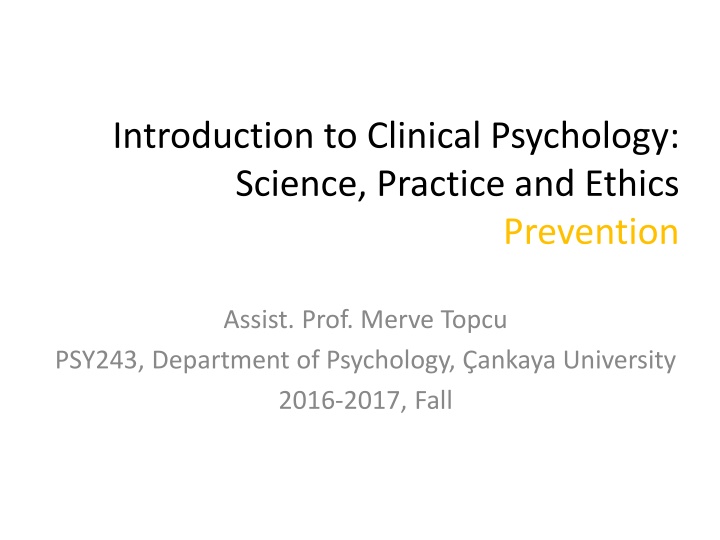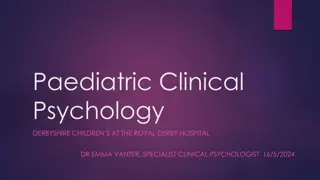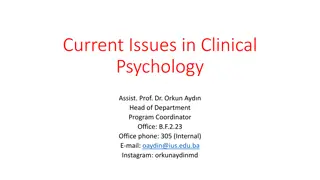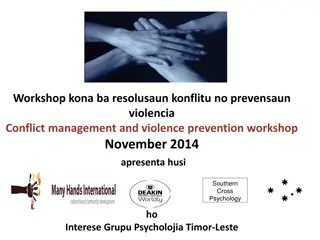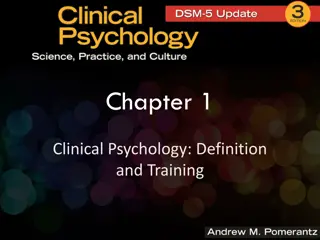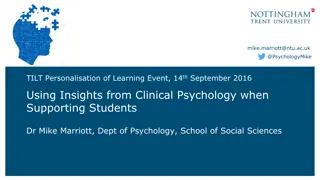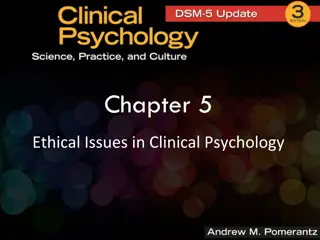Prevention Programs and Approaches in Clinical Psychology
Prevention programs play a crucial role in clinical psychology, focusing on early intervention to prevent various health problems. Primary, secondary, and tertiary interventions target different stages of disorders, while universal, selective, and indicated preventive strategies cater to different risk levels in populations.
Download Presentation

Please find below an Image/Link to download the presentation.
The content on the website is provided AS IS for your information and personal use only. It may not be sold, licensed, or shared on other websites without obtaining consent from the author.If you encounter any issues during the download, it is possible that the publisher has removed the file from their server.
You are allowed to download the files provided on this website for personal or commercial use, subject to the condition that they are used lawfully. All files are the property of their respective owners.
The content on the website is provided AS IS for your information and personal use only. It may not be sold, licensed, or shared on other websites without obtaining consent from the author.
E N D
Presentation Transcript
Introduction to Clinical Psychology: Science, Practice and Ethics Prevention Assist. Prof. Merve Topcu PSY243, Department of Psychology, ankaya University 2016-2017, Fall
Prevention in general Prevention programs were first established to prevent physical health problems. simple practices such as hand-washing, more intrusive procedures such as quarantining and wearing masks challenging tasks such as the development and use of vaccines Lifestyle factors are associated with many health problems Many prevention efforts also focus on encouraging the development of healthy habits such as good nutrition, regular exercise, and adequate sleep. Health promotion increase activities that are beneficial to many aspects of physical health
Prevention in general Community psychology, focuses on the reciprocal relations between individuals and the community in which they live Health psychology Prevention programs are often delivered by service providers who are not Clinical psychologists the role of the clinical psychologist is more likely to be in program development, training, supervision, and evaluation than it is in front-line service provision Prevention is based on the principle of early intervention E.g., Promote effective parenting Prevent various types of violence Prevent internalizing disorders Prevent substance abuse Prevent problems in those exposed to trauma or loss
Approaches to prevention The Commission on Chronic Illness (1957) identified 3 different types of intervention with respect to illness: Primary Primary intervention occurs before a disorder has developed and is designed to prevent the development of the disorder. Secondary When a disorder is evident; we usually refer to this type of intervention as treatment. Tertiary Intervention occurs with respect to a chronic disorder and focuses on rehabilitation and long-term adaptation Both for mental & physical disorders
Prevention programs Universal preventive interventions applied to an entire population E.g., Television advertising campaigns about flu, violence Selective preventive interventions target people who are at elevated risk of developing a particular disorder or problem E.g., during an outbreak of a contagious disorder Indicated preventive interventions target people who do not meet criteria for a disorder but who have elevated risk and may show detectable but subclinical signs of the disorder E.g., Those who have come into contact with a confirmed case of an infectious disorder
Prevention programs Aims promoting health Risk factors are characteristics of the individual or the environment that render a person more vulnerable to the development of a problem or disorder or that are associated with more severe symptoms. Protective factors are those characteristics that protect high-risk individuals from developing the problem or disorder.
Risk Factors for the Development of Psychopathology in Children and Youth Individual Factors Complications in pregnancy and/or birth Physical health problems or disability Difficult temperament Poor nutrition Intellectual deficit or learning disability Attachment problems Poor social skills Low self-esteem Impulsivity Attention deficits School Context Bullying Peer rejection Deviant peer group Inadequate behavior management
Risk Factors for the Development of Psychopathology in Children and Youth Family/Social Factors Parental isolation Single parent Antisocial role models in family Exposure to family or community violence Harsh or inconsistent discipline Inadequate supervision and monitoring Parental abuse or neglect Long-term parental unemployment Criminality in family Parental psychopathology
Risk Factors for the Development of Psychopathology in Children and Youth Life Events and Situations Abuse Family disruption Chronic illness or death of family member Poverty Unemployment Homelessness Parental imprisonment War or natural disasters Witnessing trauma Migration High-density living Poor housing conditions Isolated from support services including transport, shopping, recreational facilities
Risk Factors for the Development of Psychopathology in Children and Youth Community and Cultural Factors Socioeconomic disadvantage Social or cultural discrimination Isolation Exposure to community violence or crime
Prevention Carefully monitor its implementation to ensure that it is conducted as planned The prevention program is likely to be implemented in numerous agencies that vary in their resources and staff skills. Both the program s short- and long-term outcomes must be monitored in order to fully evaluate its impact. test whether there was a clinically significant reduction in their symptoms determine whether or not they meet criteria for a diagnosis Whether participants now score in the normal range on a particular measure
Protective Factors for the Development of Psychopathology in Children and Youth Individual Factors Easy temperament Adequate nutrition Positive attachment Above-average intelligence School achievement Problem-solving skills Social competence Optimism Positive self-esteem
Protective Factors for the Development of Psychopathology in Children and Youth Family/Social Factors Supportive, caring parents Authoritative parenting Family harmony Supportive relationship with another adult (aside from parents) Strong family norms and prosocial values School Context Prosocial peer group Required responsibility and helpfulness Opportunities for some success and recognition of achievement School norms against violence Positive school home relations
Protective Factors for the Development of Psychopathology in Children and Youth Life Events and Situations Adequate income Adequate housing Community and Cultural Factors Attachment to networks within the community Participation in church or other community groups Strong cultural identity and ethnic pride Access to support services Community/cultural norms against violence
Designing and Evaluating Prevention Research Identify the target: What do you want to prevent? Determine how serious the problem is. How many people are affected? What are the costs of the problem, in human suffering, health care costs, etc.? Review the research evidence about the problem. What do we know about how the risk factors develop? What variables make it more likely that a problem will develop? Identify high-risk groups. These are the factors that have been shown to moderate risk. What is known about protective factors? Design the intervention: How will the target condition be prevented? Is there an evidence-based prevention program for this problem? If so, does it need to be modified for my community? Design the study: How will you know whether the intervention is efficacious?
Effectiveness Controlled studies for effectiveness Meta-analytic reviews of prevention programs are very useful in identifying the types of programs Effectiveness refers to the extent to which a prevention program achieves desire outcomes when used in an applied setting rather than in the original research conditions. It is important that the program be evaluated to determine its usefulness in each setting in which it is applied.
Promoting evidence-based parenting Parents play a key role in their children s socialization & development of child & adolescent psychopathology Three evidence-based programs that have been developed to promote good parenting 1. Home Visiting Programs 2. Triple P 3. Incredible Years
Promoting evidence-based parenting 1. Home Visiting Programs program offering services to low-income teenage single mothers expecting their first child Home visits were conducted by trained nurses beginning during the pregnancy and continuing after the child s birth. taught skills in both self-care and child care and promoted women s use of the health care system benefits for children in terms of reducing child abuse and neglect reducing the number of arrests, convictions, substance abuse problems, and sexual promiscuity in the children when they reached the age of 15
Promoting evidence-based parenting 2. Triple P, Positive Parenting Program (a) enhance knowledge, skills, and confidence of parents (b) promote safe environments for young people (c) promote children s competence through positive parenting practices a multilevel system that provides interventions of gradually increasing intensity, according to the level of need
Promoting evidence-based parenting http://www.triplep.net/glo-en/home/
Promoting evidence-based parenting 3. Incredible Years training program originally designed to help children ages 3 8 who had been identified as having conduct problems train parents in skills effectively play with their child provide praise for positive behaviors set limits on unacceptable behaviors using time-out, ignoring, appropriate consequences problem solving An advanced 9- to 12-session program targets parents. interpersonal difficulties by teaching problem solving, anger management, communication, emotional regulation skills, and support-seeking skills.
Prevention of violence Physical Abuse of Children The deliberate infliction of injury on a child Home visiting programs, behavioral parent training programs, and multimodal programs were effective in modifying the risk of physical abuse Behavioral training and stress management Improvements in parenting skills were evident in the short-term only and were not maintained at follow-up
Prevention of violence Youth Violence: Bullying & Delinquency Common reasons due to problems with aggressive and noncompliant behavior Young people are very resistant to efforts to change their behavior Therefore, more sense to try to prevent its development in the first place There is some overlap between the types of programs designed to prevent violence and delinquency and those designed to treat oppositional defiant disorder and conduct disorder in young children.
Prevention of violence Youth Violence: Bullying & Delinquency (cont d) Home visits, Triple P, and Incredible Years School-based interventions Directly target aggression and violence by training students in anger management and conflict resolution Aims improvements in prosocial behaviors Teachers are the key agent of change Their recognition of a problem with bullying Their commitment to the program are essential to its effective implementation
Prevention of violence Youth Violence: Bullying & Delinquency (cont d) The Fast Track Project (1990) A multiyear program based on available research on risk and protective factors in the development of conduct disorder Program was designed to assess the feasibility of engaging community stakeholders in the project maintainingthe program s fidelity while responding to local needs maintaining community engagement so that the program would be sustainable The intervention included a child component designed to increase academic competence, emotion regulation, and social skills Discipline, support of constructive behavior, and monitoring of activities were targeted in the parent component. Group discussions were followed up by home visits The classroom component involved a curriculum designed to promote self-control, emotional awareness, and social problem solving. 37% less likely to have serious problems than were children in the control group
Prevention of violence Youth Violence: Bullying & Delinquency (cont d) Although the total elimination of disorders or illnesses would be ideal, prevention programs usually have a more realistic goal of reducing the incidence of disorders. 37% less likely to have serious problems than were children in the control group High-risk children who participated in the program had better social competence, fewer problems in social cognition, less involvement with deviant peers, and fewer conduct problems than did high-risk children who did not participate
Prevention of internalizing disorders The person with internalizing problems may suffer quietly on his or her own without coming to anyone s attention. Anxiety Risk factors for the development of anxiety Inhibited temperament Avoidant coping style Overprotective parenting practices Parental anxiety
Prevention of internalizing disorders Paula Barrett developed a prevention program that was adapted from an effective treatment program for children with anxiety disorders School children were screened to identify those with mild to moderate anxiety problems who were randomly assigned to an intervention group or to a monitoring group. the Coping Koala program 10 sessions w/ children 3 sessions w/ parents followed by booster sessions At 12-month follow-up, differences between the intervention group and the comparison group had diminished by the 24-month follow-up, 39% of children in the untreated group met criteria for an anxiety disorder, whereas only 20% of children in the intervention group did so Participation in the program was associated with almost a 50% reduction in the incidence of anxiety disorders at 2-year follow-up.
Prevention of internalizing disorders Barrett and Turner (2001) adapted the Coping Koala program to a format that could be used in a universal prevention program delivered by teachers Friends for Children and Friends for Youth Longer-term follow-up evaluations and replications in other cultures are under way
Prevention of internalizing disorders Risk factors for the development of depression Interpersonal skills deficits Cognitive errors Parental depression Marital conflict Negative life events Studies with a greater percentage of female participants had larger effect sizes For interventions, it is recommended including a focus on at- risk groups Being a female adolescent Offspring of depressed parents Being exposed to family-related stress such as divorce Bereavement
Prevention of internalizing disorders Preventive interventions reduce the incidence of depressive disorders by 22%. Programs based on cognitive-behavioral and interpersonal principles are promising strategies School-based programs offer an appealing avenue to circumvent adolescents avoidance of the stigma of mental health services.
Prevention of substance abuse Alcohol, tobacco, and drug use during pregnancy are associated with a host of deleterious consequences Premature delivery Low birth weight Perinatal mortality Long-term neurological and cognitive-emotional problems Tobacco is responsible for 4.1% & alcohol is for 4.0% of the total global economic costs due to disability (World Health Organization, 2004) Substance abuse is a leading cause of adolescent morbidity and mortality due to its links with motor vehicle accidents and with sexual behavior leading to unplanned pregnancies and HIV infection
Prevention of substance abuse Individual-level risks Temperamental factors Coping skills Psychopathology Exposure to negative life events 2 types of programs in general Interactive foster the development of interpersonal skills Yielded more effect size Noninteractive lecture-based Efficacy was associated with active parental involvement in developing social competence and self-regulation.
